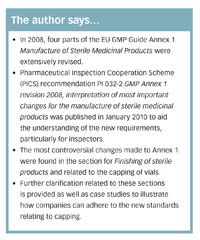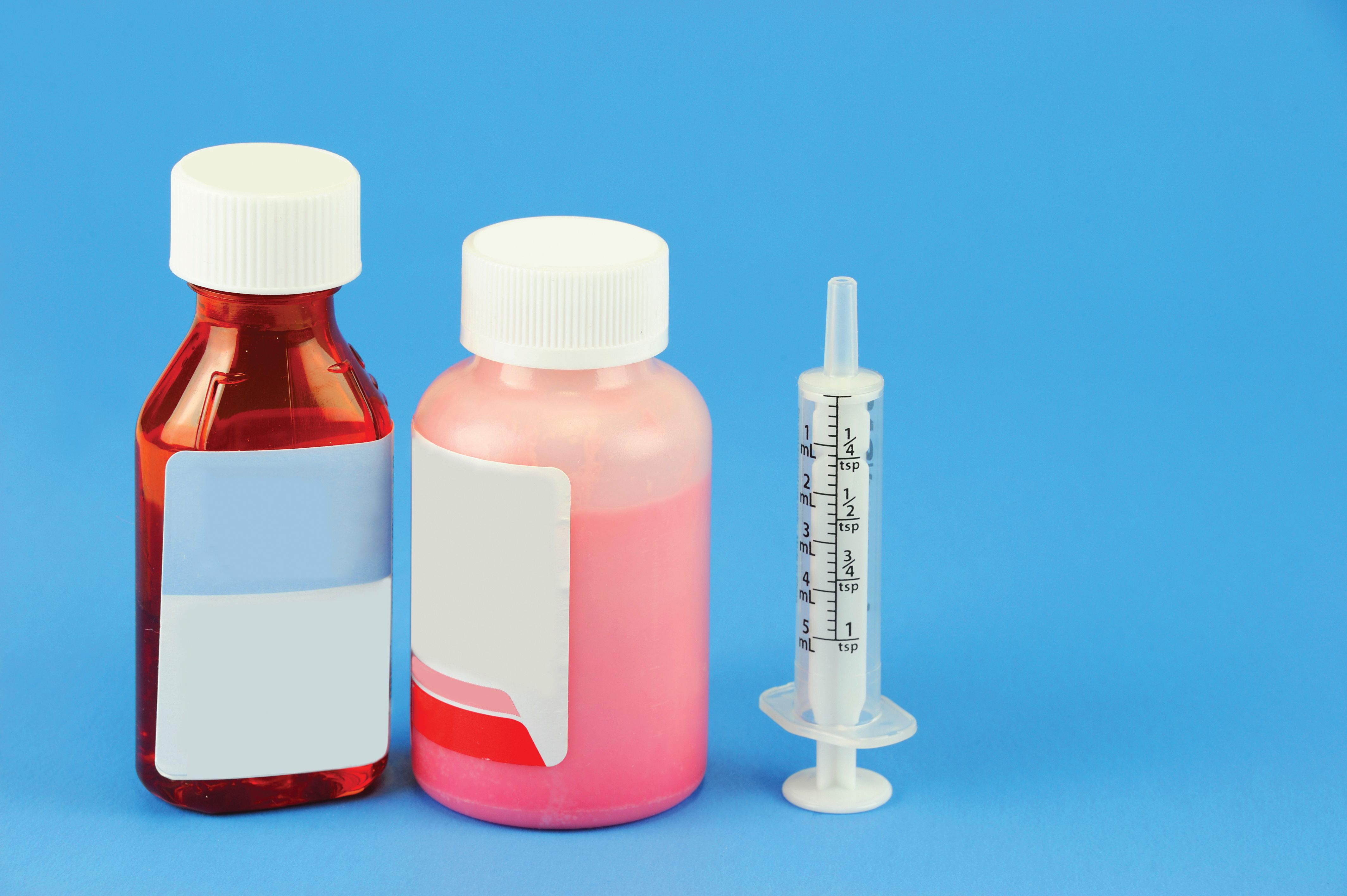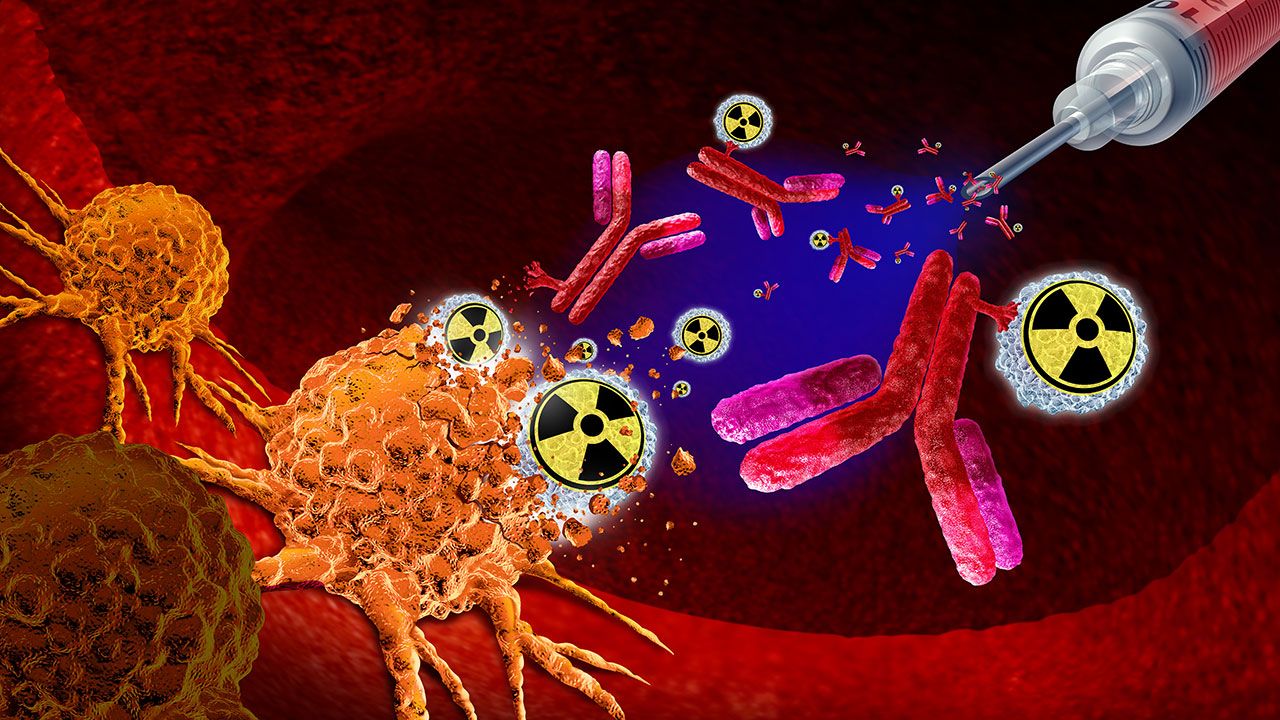News
Article
Pharmaceutical Technology Europe
Pharmaceutical Technology Europe
Sterile Production According To The New EU GMP Annex 1: A Focus On Capping
Author(s):
The recent amendment to Annex 1 has seen controversial changes relating to the capping of vials.
Regulations governing the manufacture of sterile pharmaceuticals in the US and Europe have been significantly revised over the past few years. The first milestone was set by the FDA's Guidance for Industry Sterile Drug Products Produced by Aseptic Processing" — "Aseptic Guide in 2004. In 2008, four parts of the EU GMP Guide Annex 1 Manufacture of Sterile Medicinal Products were extensively revised. Annex 1 became fully effective on 3 January 2010.

GETTY IMAGES/CHRISTINE BALDERAS
Another important document that often receives little attention is the PIC/S (Pharmaceutical Inspection Cooperation Scheme; www.picscheme.org) recommendation PI 0075 "Validation of Aseptic Processes". Primarily aimed at pharmaceutical inspectors, this document also aids the pharmaceutical user in the interpretation and implementation of the new Annex 1 standards. In the course of the Annex 1 revision, the PIC/S document underwent several revisions and now corresponds with the current guideline.
The revised version of EU GMP Guide Annex 1 Manufacture of Sterile Medicinal Products
The revised version of Annex 1 primarily applies to four partial aspects:
- Clean room and clean air device classification
- Process simulation / media fill
- Bioburden monitoring
- Finishing of sterile products
Clean room and clean air device classification has been developed to be harmonised with the standard EN ISO 14644. For Process simulation / media fill the requirements were harmonised with the standards of the FDA Aseptic Guide. These standards were also adopted in the PIC/S document PI 007-5. The specifications for Finishing of sterile products generated a much higher need for text interpretation. The new specifications, particularly for capping vials, have also caused uncertainty for inspectors in the pharmaceutical industry.
To eliminate this uncertainty, the PIC/S published another document in January 2010, introducing the changes in Annex 1 and interpreting the new specifications. The document PIC/S recommendation PI 0322 GMP Annex 1 revision 2008, interpretation of most important changes for the manufacture of sterile medicinal products was prepared under the leadership of Swiss inspectors from Swissmedic.
The most controversial changes made to Annex 1 were found in the section for Finishing of sterile products and related to the capping of vials. Some statements in Annex 1 concerning this matter were clarified in the PIC/S document and are presented here in more detail. The PIC/S interpretations are supplemented with two case studies from pharmaceutical companies.

The author says...
Interpretations
1. "Grade A air supply" — definition, qualification and monitoring requirements (Annex 1 Section 120)
"Grade A air supply" was listed again in Annex 1 but not defined. PIC/S clearly explains the need to discern between Grade A air supply and Grade A area and defines the terms as follows:
"Grade A air supply is specifically used to describe a supply of air which is HEPA filtered, and at the point of supply meets, when tested, the non-viable particulate requirements of a Grade A area."
It is important to differentiate between the terms Grade A air supply and Grade A area. According to PIC/S, a Grade A air supply should be qualified and monitored; the qualification is to be performed in an "at rest" state. For the capping machine the "at rest" state is achieved when the air intake is switched on, the machine is operating (but without vials being fed and needing to be capped), and there is no user operation. For the transport tunnel the "at-rest" state is reached when the air intake and the conveyer are switched on and there is no user operation.
The requirements for nonliving particles are to meet Grade A area requirements. The sample is to be taken from beneath the air outlet and smoke studies are to be performed. A unidirectional air flow is not required. However, an efficient protection for the vial is to be proven, particularly an absence of ambient air entering. Rational air speed limitations should exist. Companies must determine monitoring requirements for nonliving particles and microbiological contaminations in line with a risk analysis.
2. Handling missing or displaced stoppers (Annex 1 Section 121)
Great importance is placed on the detection of missing or displaced stoppers prior to capping. These vials are to be rejected prior to capping. For validated processes the ejection of "bad vials" is also accepted after capping; but the ejection prior to capping is clearly preferred. The better the controls for correctly set stoppers and demonstrating the packaging integrity, the lower the requirements can be for the surrounding area. In the absence of such a control system, capping must be performed as an aseptic process.
3. The use of RABS or Isolators (Annex 1 Section 122)
There is no direct requirement for using RABS or isolators during capping. Human interaction in this process can also be reduced with other methods.
Company case studies
Case study 1
It is important to understand at which point vials with stoppers can be considered as sealed and how the requirements for a "Grade A air supply" should be interpreted. The selected approach for interpreting and implementing Annex 1 requirements is presented below using a case study from a pharmaceutical company:
Section 120 of Annex 1 states that: "Vial capping can be undertaken... as a clean process outside the aseptic core. Where this latter approach is adopted... and thereafter stoppered vials should be protected with a Grade A air supply until the cap has been crimped."
The "Grade A air supply", as defined in Annex 1, definitely does not correspond with the requirements of a clean room Grade A as defined by the EU GMP Guide; for example, where Grade B is a background for Grade A. Based on the interpretations of PIC/S, the "Grade A air supply" is the air quality at the air outlet location and this must meet the particulate requirements of Grade A.
Section 121 of Annex 1 states that: "Vials with missing or displaced stoppers should be rejected prior to capping. Where human intervention is required at the capping station, appropriate technology should be used to prevent direct contact with the vials to minimise microbial contamination."
In this particular case study, a camera system, which detects displaced stoppers prior to capping, was introduced to meet this requirement. Because of the spatial configuration and the past robustness of the process these vials were not automatically discharged prior to capping. In the event that a displaced stopper is detected the machine is stopped and the employee intervenes on the vial using tweezers. The microbiological monitoring data collected so far showed no abnormalities with this method. In addition, settle plates are routinely laid out and evaluated.
Section 122 of Annex 1 states that: "Restricted access barriers and isolators may be beneficial in assuring the required conditions and minimising direct human interventions into the capping operation."
These requirements were interpreted in a way that a RABS (restricted access barrier system with gloves) is not mandatory. The equipment is cabinised, thus limiting interference, but gloves are not used. Access by employees is rather organisationally and technologically kept to a minimum, and is controlled microbiologically by the settle plates.
Case study 2
The following case study also describes the implementation of Annex 1 requirements at a pharmaceutical company prior to the publication of PIC/S document PI 0322. In this case, in addition to the European requirements, the respective American standards had to be met, as is typical for international companies.
Part IV Buildings and Design, section E "Design" of the FDA Aseptic Guide from September 2004 states: "If stoppered vials exit an aseptic processing zone or room prior to capping, appropriate assurances should be in place to safeguard the product, such as local protection, until completion of the crimping step. Use of devices for on-line detection of improperly seated stoppers can provide additional assurance."
The process described in this case study consists of:
- Filling — placing stopper — lyophilisation — stoppering inside of the freeze dryer in clean room Grade A.
- Capping under HEPA filtered air in clean room Grade C.
According to the Annex 1, the key point is to safeguard the product prior capping. Therefore the standard process capping with laminar flow in clean room Grade C was reassessed.
The core concern of the concept is the need to ensure the integrity of the containers. The specification was that the packaging combinations must be microbiologically sealed even without crimping caps. On one hand, this requires developing and optimising suitable packaging combinations; on the other hand it requires adequate process know-how, and finally ensuring a suitable process control concept.
For this concept the fundamental questions are:
- How to test microbiological tightness?
- How to handle packaging deviations and how to test the worst case combination?
- Which process control tools are necessary and suitable?
To address the microbiological tightness, a stronger and easier measurable criterion, the gas tightness, was defined. Therefore, various methods were used during packaging development to define the parameters for "gas tightness" of the packaging combinations. Methods used here were frequency modulated spectroscopy (FMS) and the helium leak test, whilst the methylene blue dye ingress test was used to check the tightness of the stoppered vials. To address the worst case, packaging combinations near the upper specification limits and tighter test limits were chosen. The packaging combinations and design space based on the parameter settings (e.g., to which stopper seat height is the seal gas proof) generated in development are used to define the production process. Furthermore, as a safeguard measure, the seat of the stopper is 100% monitored with a sensor barrier and a camera system.
With this, the validity of the process — proving reproducible stoppered vial tightness — is ensured through compliance with the process parameters.
Conclusion
The PIC/S document 0322 eliminated some uncertainties and clarified some requirements of the revised version of EU GMP Guide Annex 1 Manufacture of Sterile Medicinal Products. In the future, inspectors will certainly use these interpretations as a guide. However, there is still enough leeway to adapt the Annex 1 requirements to the actual company setting, notwithstanding the PIC/S interpretations.
Dr Andreas Mangel is Vice President of PCA, a Business Unit of Concept Heidelberg, Germany.
Newsletter
Get the essential updates shaping the future of pharma manufacturing and compliance—subscribe today to Pharmaceutical Technology and never miss a breakthrough.






